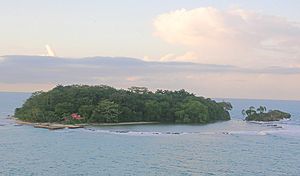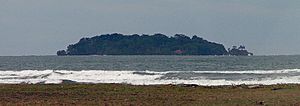Uvita Island facts for kids
|
Native name:
Quiribrí
Nickname: La Huerta
|
|
|---|---|

Uvita Island
|
|
|
Location in Costa Rica
|
|
| Geography | |
| Location | Caribbean Sea |
| Coordinates | 09°59′37.68″N 83°0′40.68″W / 9.9938000°N 83.0113000°W |
| Area | 0.8 km2 (0.31 sq mi) |
| Length | 420 m (1,380 ft) |
| Width | 315 m (1,033 ft) |
| Highest elevation | 15 m (49 ft) |
| Administration | |
| Demographics | |
| Population | 0 |
Uvita Island, also known as Isla Uvita, is a small island off the coast of Limón in Costa Rica. Its official name is Isla Quiribrí. The island is located in the Caribbean Sea, about 885 meters (about half a mile) from the port of Limón.
Uvita Island is quite small, covering an area of 0.8 square kilometers (about 0.3 square miles). It is about 420 meters (1,378 feet) long from north to south and 315 meters (1,033 feet) wide. No one lives on the island today, but there is a building and a small dock. You can visit the island by renting a boat from the fishing docks on the Cieneguita River.
What is Uvita Island's Name?
Uvita Island has had many names over time. In English, it was sometimes called Grape Cay or Grape Island. In Spanish, people often call it Isla Uvita or La Uvita. The native Cariari people, who lived there long ago, called the island Quiribrí.
In 1986, a group called the National Commission of Nomenclature decided to bring back the name Isla Quiribrí. Later, in 2002, another group asked that this official name be used more often. This was done during the 500th anniversary of Christopher Columbus's visit to the island. Even though Isla Quiribrí is the official name, most local people and even government maps still use Isla Uvita.
When Did Christopher Columbus Visit Uvita Island?
A famous explorer, Christopher Columbus, visited Uvita Island in 1502. He stopped there during his fourth and final trip to the Americas. His ships needed repairs, so they stayed on the island for two weeks. Columbus named the island La Huerta, which means "the orchard" in Spanish.
During their stay, Columbus and his crew met the local Indigenous people. These people were very welcoming and wore clothes decorated with gold. Because of this, some people mistakenly thought Columbus named the whole country Costa Rica, meaning "rich coast." However, the name Costa Rica was actually first used much later, in 1538, by a Spanish court.
See also
 In Spanish: Isla Uvita para niños
In Spanish: Isla Uvita para niños



